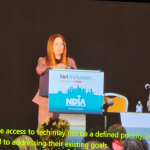 The National Digital Inclusion Alliance’s (NDIA) annual conference occurred in Philadelphia, Pennsylvania from February 13 through the 15th in 2024. With over 1300 attendees, it was the largest digital inclusion conference to date. Many parts of the conference were live-streamed and are available on YouTube. Maryanna Milton, Barry Glicklich and Katherine Lato attended the full conference. Presentation information and background resource notes for the breakout sessions, along with collaborative notes from session attendees are all on sched. (Click on the link to a session you are interested in, then find the link to Collaborative Note-Taking Document and click on that.
The National Digital Inclusion Alliance’s (NDIA) annual conference occurred in Philadelphia, Pennsylvania from February 13 through the 15th in 2024. With over 1300 attendees, it was the largest digital inclusion conference to date. Many parts of the conference were live-streamed and are available on YouTube. Maryanna Milton, Barry Glicklich and Katherine Lato attended the full conference. Presentation information and background resource notes for the breakout sessions, along with collaborative notes from session attendees are all on sched. (Click on the link to a session you are interested in, then find the link to Collaborative Note-Taking Document and click on that.
Key Messages/Themes:
- Relationships are very important. Build them. Maintain them.
- Win the trust of the people.
- We don’t have years to adapt to technology changes.
- Infect other people with the virus of digital equity.
- It’s not a sprint, it’s a marathon. Life-long transformative experience.
- Respect that each person being helped is a unique person with unique needs.
- Don’t reinvent the wheel.
- Remember to consider both breadth and depth of the solutions you provide.
- Take an interdisciplinary approach–bring in as many perspectives as possible.
- Data Collection is a part of every state equity plan. Include this in your plans.
- Craft the communication based on feedback from coalitions.
- Read your state’s broadband plan and talk to the people at the state level.
- Live your life building authentic relationships.
This is one of Barry’s favorite parts of Net Inclusion- seeing the programs within the communities where they are operating. The Philly Community Wireless initiative is very exciting, providing a publicly accessible mesh network for housing and public areas throughout the Norris Square Neighborhood. It works with local residents and businesses to host the equipment (with a cost of $25/year to provide electricity). The staff were very knowledgeable, friendly, and generous with the people on the tour. The tour included the Philadelphia Free Library Central building, Philly Cam and the host of Talking Tech with Wayne, and the Drexel University Dornslife Center for the local community. A highlight of Philly Cam was the camera loaning packages for people to use in their communities to film and create news stories.
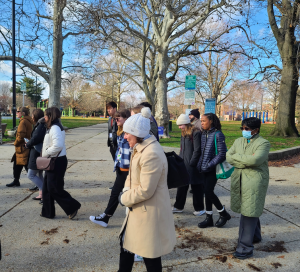
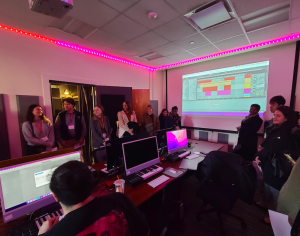
Sessions attended by PBDD board members follow.
Pioneering a new Approach to Digital Access Inclusion
In this well coordinated session, they talked about identifying the missing middle, where people are trained but still do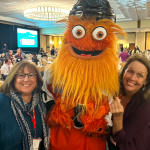 not receive job offers. Companies wanted experience, so they updated their training to include exercises so people could gain that experience. It helped, but the target keeps moving. Another issue is assuming baseline digital literacy in the people they were training and that was often wrong.
not receive job offers. Companies wanted experience, so they updated their training to include exercises so people could gain that experience. It helped, but the target keeps moving. Another issue is assuming baseline digital literacy in the people they were training and that was often wrong.
Organized Advocacy: The Need for Local Coalitions and State Networks
 Panel had a variety of perspectives and length of time in coalition work. General themes: Someone has to lead the coalition. Can bring in a consultant. Decisions must be made and goals/priorities developed. Suggested taking tours of member locations and meeting in person there once a quarter. Have workgroups that report back to the coalition. Pay people for their work time. Make meetings less talking ‘to’ and more communicating with people.
Panel had a variety of perspectives and length of time in coalition work. General themes: Someone has to lead the coalition. Can bring in a consultant. Decisions must be made and goals/priorities developed. Suggested taking tours of member locations and meeting in person there once a quarter. Have workgroups that report back to the coalition. Pay people for their work time. Make meetings less talking ‘to’ and more communicating with people.
Digital Equity Funders: Perspectives from Partnerships
Push back against transactional grants. Make sure your organization’s values are recognized by the grantor. Try to express the ripple effect of your grantor’s investment. Be honest about capacity and ask for additional staffing when needed. Invite funders to your events.
From a Funder’s Lens: How to Leverage DE Grants
Lead with data. Use Lead for America for additional free staffing. Don’t chase funding.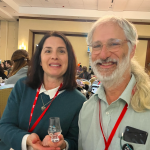 OK to say no. Be honest about where you can and do serve. Example: entire state, a city, one county. Try to express collective impact with partner organizations. Look for gaps that can be filled. Get permission to tell stories or better yet, have people tell their own stories.
OK to say no. Be honest about where you can and do serve. Example: entire state, a city, one county. Try to express collective impact with partner organizations. Look for gaps that can be filled. Get permission to tell stories or better yet, have people tell their own stories.
Collaborative Grant Writing for Digital Equity
First time, it’s a draft. Keep submitting. Build your relationships. Quality of relationships affects the quality of your grants. Infect other people with the virus of digital equity.
Connecting Digital Skills to the Adult Learning Ecosystem
 Adult learners fall into many of the covered population categories. Partner with Adult education programs. Help adult learners see patterns among programs. Examples: search button symbol, various word processing programs have similarities and menus, power button and symbol on many devices. Learn together with adults. Show how making mistakes and exploring is part of the process. Ask adult learners what they want to do.
Adult learners fall into many of the covered population categories. Partner with Adult education programs. Help adult learners see patterns among programs. Examples: search button symbol, various word processing programs have similarities and menus, power button and symbol on many devices. Learn together with adults. Show how making mistakes and exploring is part of the process. Ask adult learners what they want to do.
From Alaska to Appalachia: Rural Outreach & Engagement for Digital Inclusions
Building trust — ask for stories and give something/knowledge in return. Build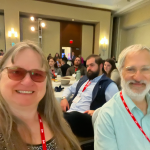 relationships with people who are the leaders in their communities. Listen well. Go to community events. Figure out who isn’t in the room who should be, and work to get them there. Don’t worry about too many people, or too few. Just get started. Understand that all this work is about people. Stuff happens when you already know who to talk to. It’s not a sprint, it’s a marathon. Life-long transformative experience. Don’t reinvent the wheel.
relationships with people who are the leaders in their communities. Listen well. Go to community events. Figure out who isn’t in the room who should be, and work to get them there. Don’t worry about too many people, or too few. Just get started. Understand that all this work is about people. Stuff happens when you already know who to talk to. It’s not a sprint, it’s a marathon. Life-long transformative experience. Don’t reinvent the wheel.
Creating the Systemic Digital Equity Mindset
A primary goal is to keep the efforts moving forward with momentum. Digital Equity is an interdisciplinary issue, and should involve people with broad perspectives and expertise. It can be very helpful to offer digital equity in the context of wrap-around services, bearing in mind that each client being helped is a unique person with unique needs. Leadership needs to take a broad perspective, while the partner organizations can provide deep expertise. Data collection is important- it’s part of every state digital equity plan, funders will want to see it.
It Takes a Village- Models to Support Digital Health Equity
Internet access is a determinant of health. Digital health is broader than tele-health. It encompasses all the technology supporting health or healthcare, analyzing data to understand and improve health, and make sense of the data to identify causes and solutions. Final takeaway include finding partners and bringing solutions to where the people are.
Insights from HBCU-led Digital Inclusion Initiatives
HBCUs have launched projects within their communities to collaborate with other organizations and improve digital equity. A five-component framework was discussed: collaboration, stakeholder mapping & alignment, tailoring solutions, sustainability, and program evaluation throughout the duration.
Getting off the Page: Practical Tips to Advance Digital Equity
Some cities have been doing this work for a long time, longer than the states. You think you know how the government works until you’re the first person doing a new job.
PCs for People Reception
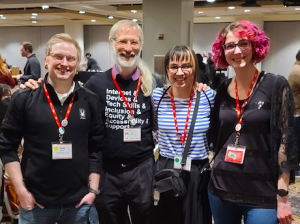 Once again, PCs for People provided the attendees a chance to mingle and talk and enjoy themselves with food and drink. Always a great opportunity for chance encounters- we saw two digital navigators from community colleges in disparate states connect with each other, and had the opportunity to meet a couple of the representatives from organizations that we sponsored to come to Net Inclusion.
Once again, PCs for People provided the attendees a chance to mingle and talk and enjoy themselves with food and drink. Always a great opportunity for chance encounters- we saw two digital navigators from community colleges in disparate states connect with each other, and had the opportunity to meet a couple of the representatives from organizations that we sponsored to come to Net Inclusion.
Conclusion
Check out the conference on YouTube and by clicking on topics of interest in sched. You can often find the presentations as well as collaborative notes taken during the sessions. And, make plans to attend Net Inclusion next year in Gila River, Arizona May 20-22, 2025.
— Katherine, Barry, Maryanna
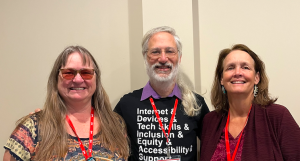
 Bus Tour
Bus Tour